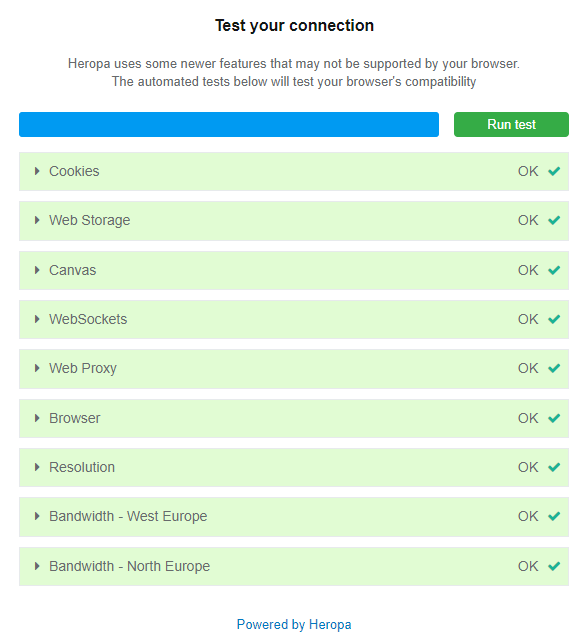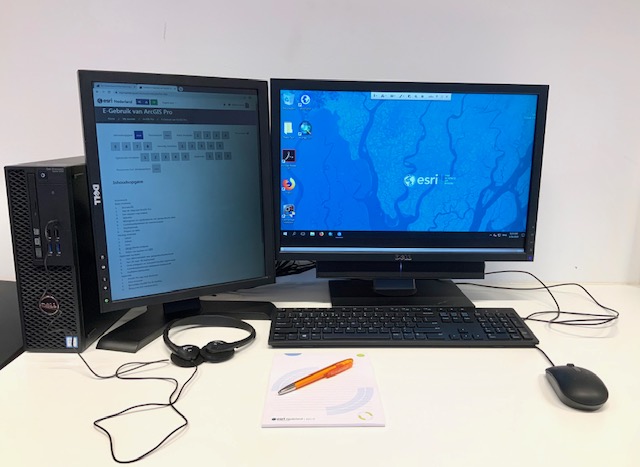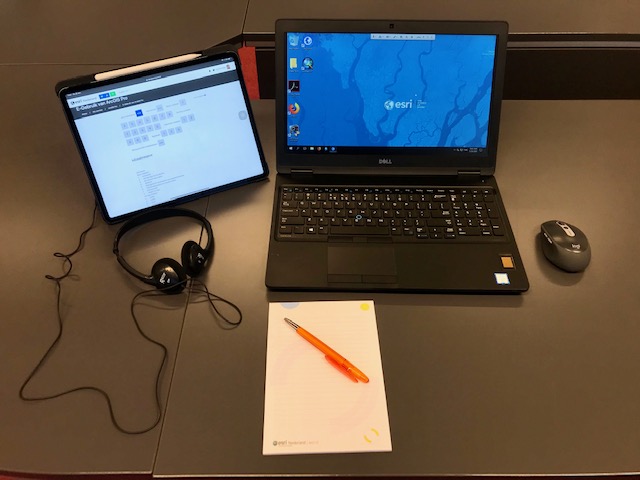Pre-check virtual training (Eng)
Cursus: Pre-check virtual training (Eng) | mijnopleiding.esri.nl
-
-
Instructies: klik op de titel van de sectie om de sectie te openen en/of sluiten.
-
Introduction
Welcome to the pre-check of Esri Nederland for (virtual) training courses, to be taken from your workplace at home or at the office.
In this pre-check, you will go through a number of steps and tests to see if you can successfully follow the training course.
Perform this pre-check well in advance, but no later than one working day before the start of the training course. If you have any problems, please contact opleidingen@esri.nl
On the day itself the teacher cannot help you wilt your technical problems.
-
Table of Contents
1. Introduction
2. Table of Contents3. Pre-check checks:
4. Frequently asked questions:Step 1: Check the hardware and software requirements
Step 2: Test Internet speed Internet BrowserPage 3: Which hardware setup can I use?
Page 4: What is the lesson schedule / what are the contact hours?
Page 5: What should I do on the lesson day itself? -
Step 1: Check hardware and software requirements
WHAT ARE THE MINIMAL REQUIREMENTS?
What do you need to take a virtual training course?- A computer with an internet connection (preferably > 10mbps)
- A current internet browser (for example Chrome or Firefox)
- A microphone (a headset for a desktop computer or the built-in microphone in a laptop)
- Optional: a camera
WE RECOMMEND IN PARTICULAR:- Windows 10 or 8.1 (Pro or Enterprise edition). If you are working with a Mac computer, the at least Mac OSX version 10.11 must be installed. See here for the exact specifications.
- Linux is not supported for Webex.
- A wired, high-speed internet connection. WIFI is possible but test in the pre-check (step 3) if the speed is sufficient.
- We do not recommend using Citrix or Terminal Server to connect. It is
often more convenient and stable to use a local PC or private PC.
- An HTML 5-enabled web browser met cookies, JavaScript ActiveX and plug-ins enabled.
- The ability and privileges to connect to a virtual machine using Remote Desktop Protocol (RDP) or to install the Remote Desktop app if required.
- The ability and privileges to install a Webex client for communication.
- A firewall configuration that provides access to ports 443 and 3389. Proxies must be disabled or configured to allow access. This is usually already the case at home.
- The PC must be able to transmit sound through a headset or speakers. If you want to be able to communicate with the teacher via the PC, a separate or built-in microphone is required.
- To carry out the exercises, it is useful to connect your PC or PCs to two screens. A tablet as an extra screen is also a possibility.
-
Step 2: Test Internet speed Internet Browser
A virtual training takes place from your own workplace. We provide a practice computer, equipped with all necessary software and licenses.In order to participate in the training, you must provide:
- Two screens (a tablet can also be used as a second screen).
- A microphone (for example: the built-in microphone in your laptop or a headset) and optionally a camera.
- A stable internet connection, you can test your connection and network performance with the test below.
Requirements:
- Take this test from the location where you will be training.
- We recommend a wired, high-speed internet connection. Wifi is possible but the test below of this is fast enough.
- Run this test on a local machine (not on a Citrix or Terminal Server or with an active VPN connection).
- Use an Internet browser that supports HTML5, such as Chrome, Edge, Firefox, or Safari.
- Internet Explorer is not supported.
Test- Click here for the test.
- Click Run test
The test is successful when a screen similar to the one below appears:

In case of problems, please contact your own IT department.
Does the test show that your browser cannot access the camera or do you not have a webcam? Preferably you use a webcam, but if this is not possible you can still attend the training. However, for interactive training we recommend the use of cameras.
-
Step 3: Which hardware setup can I use?
During the training you use your own hardware. What exactly do you need?
You will use the following applications during the training:
- the Online Learning Environment (browser)
- the Teams environment (Teams app)
- the Virtual machine with Esri software (Remote desktop app or browser).
Therefore, it is useful to have at least two screens.
Figure 1 below shows an example configuration. In this configuration, two monitors are connected to a PC. The left screen displays the Online learning environment (https://mijnopleiding.esri.nl/) and the Teams environment. The right screen displays the virtual machine.This is especially useful when doing the exercises. On the left you have the exercise document (PDF) in which the exercises are written out and on the right you have the ESRI software at your disposal. In any case, listening to the videos (via the online learning environment or listening to the teacher (during the virtual classroom courses with Webex) takes place on the local computer (NOT in the virtual environment).
Figure 1
Another possible setup is shown in figure 2 below. This configuration consists of a tablet and a laptop. Both are connected to the Internet but not to each other.
The table (in this example an Ipad) displays the Online Learning environment (https://mijnopleiding.esri.nl/) and the Micrsoft Teams environment. The laptop displays the virtual machine. The disadvantage of this setup is that demos of a teacher are difficult to see and that you cannot cut and paste text from the exercise to the virtual machine. In general, that is not a problem. You sometimes have to type a little more text. In this setip the Webex environment could also be displayed on the laptop.

Figure 2
Below a general checklist:
- Find a quiet place
- Use two screens (e.g. laptop and tablet)
- Use headphones
- Use a microphone (e.g. a headset for a desktop/laptop or of the built-in microphone on a laptop)
- Keep your cell phone handy with the number of the teacher in case of any problems
-
What is the lesson schedule / What are the contact hours
The schedule for training courses is:
09:30 - 12:30
12:30 - 13:30 Lunch break
13:30 - 16:30
For virtual classroom training: the teacher may deviate from this schedule.For virtual e-learning the above times are the times you can contact the teacher. -
What should I do on the lesson day itself?
Before the training, you will receive an invitation email with a link to the virtual classroom, which includes a link for the Teams training session and a link to a practice computer equipped with the appropriate Esri software.
On your first training day, you will also gain access to the training materials in Esri Nederland’s Online Learning Environment. The training materials will be available for one year and include videos explaining the theory, demos, and PDFs with exercises. You can also find the practice data here, though it is already installed on the remote computer.
Logging into the Learning Environment through the link in the mail send to you.
On your local machine (or a tablet), open a browser (tab).
Go to: https://mijnopleiding.esri.nl.
Enter your credentials: Username / Email: the email address you registered with (usually your work email). Password: Student01 (for your first login in this environment) or your own password (if you have previously accessed the learning environment).
If this is your first time logging in, change your password (at least 8 characters long with a capital letter and a number) in your profile settings.
If you have forgotten your password, you can reset it using the green link below the password entry field.
Note: This email often ends up in your Spam folder.If you are unable to reset it, please ask the instructor for assistance. They can reset your password or request a reset through Esri Nederland's customer service (opleidingen@esri.nl).
